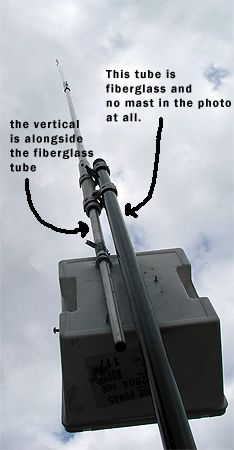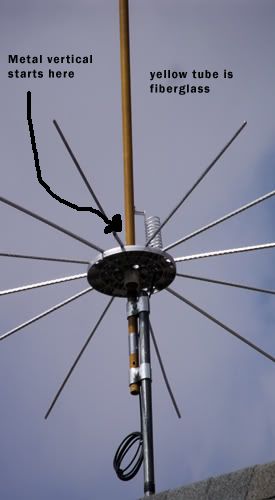You are using an out of date browser. It may not display this or other websites correctly.
You should upgrade or use an alternative browser.
You should upgrade or use an alternative browser.
-
You can now help support WorldwideDX when you shop on Amazon at no additional cost to you! Simply follow this Shop on Amazon link first and a portion of any purchase is sent to WorldwideDX to help with site costs.
End Fed 1/2 wave antenna
- Thread starter HomerBB
- Start date
It may be . . .
Well Homer, that's not what I expected to hear. But if so, it will nullify all of my experience and thinking, what Yates says on the issue, and what these models are suggesting to me, but I asked for it, so no problem.
This has been an issue for me for a long time and you're the only one I would trust with what you find, because you do more than just words.
Sounds like a lot of wisdom there NB. I can't hardly refute their results. BTW, I didn't ever claim that an end feed 1/2 wave like the A99, didn't need a counterpoise to handle the return currents, what I tried to suggest was that the A99 matching design provide enough wire to provide the counterpoise, so no radials are necessary.
Does anybody have some proof or know a way to test the ideas noted in the link above? I sure don't, but I think I can tell when the mast/feed line is radiating with common mode currents, bad enough to matter. And, even when the CMC are bad enough to matter the antenna still seemed to perform about the same, because I couldn't tell the difference just working my radio. Like I tend to ask sometimes, how much difference are we talking about here guys?
I've also had the thought that a 1/2 wave or multiple feed line is not your friend in such installations. I think my experience with such feed lines is also an issue of concern, but lots of guys use the idea, and strangely they all say it works almost flawlessly. BTW, have any of you ever used a 50' foot long feed line? I find this particular length in CB to work really well, in all respects, and that length is really random between a 1/2 wave multiple and a 1/4 wave multiple, both of which I think tend to be problematic at times.
I think my computer must still be messed up, because I don't see much response to this popular antenna and topic. Where are you Geek Squad?
Sorry Homer, I got off the subject of your thread I think. Just my curiosity and I ain't got much time to waste.
Last edited:
Marconi, I'll try to get my results posted tomorrow.
I did not use a feedline for this testing, but hooked the analyzer directly beneath the antenna feedpoint. Any need for a counterpoise that uses the feedline braid is not a factor with such a setup. Whether it was there the analyzer did not say in plain english . . .
I did not use a feedline for this testing, but hooked the analyzer directly beneath the antenna feedpoint. Any need for a counterpoise that uses the feedline braid is not a factor with such a setup. Whether it was there the analyzer did not say in plain english . . .
Marconi, I'll try to get my results posted tomorrow.
I did not use a feedline for this testing, but hooked the analyzer directly beneath the antenna feedpoint. Any need for a counterpoise that uses the feedline braid is not a factor with such a setup. Whether it was there the analyzer did not say in plain english . . .
That's good Homer, I think that is the way Yates showed his results too, right at the feed point. I'm not sure I fully understand your final words, but that is why I asked about the isolation. I was concerned that Yates didn't use a feed line as best as I recall, and if your antenna uses a mast, maybe that would affect a difference right off, so an isolated antenna might be the solution for a better test. This is just a guess however.
When you get around to posting the results, if I still have a question, we'll get to it then.
Thanks again Homer for bothering with this subject.
Last edited:
eddie,
the a99 is a bit different than say a silver rod style 1/2wave in that you cannot connect radials directly to the feedpoint due to the coax inside the mounting tube but they don't seem any better or worse than a silver rod style antenna with regards rf on the coax shield,
there could be a small difference but both can have hot coax,
when folk cut coax to 1/2wave electrical multiples say 12ft for rg213 they avoid worst case electrical lengths for the outside of the braid.
the a99 is a bit different than say a silver rod style 1/2wave in that you cannot connect radials directly to the feedpoint due to the coax inside the mounting tube but they don't seem any better or worse than a silver rod style antenna with regards rf on the coax shield,
there could be a small difference but both can have hot coax,
when folk cut coax to 1/2wave electrical multiples say 12ft for rg213 they avoid worst case electrical lengths for the outside of the braid.
To help you understand the above:In each case of the two antennas they are mounted to fiberglass tubes around five feet long. All of the electrical parts are either within or along side the upper 2.5 - 4 feet of the fiberglass. One of them is a yellow FB tube, the other is a dark green FB tube. The gate clamps are attached only to the lower part of the FB tube on the yellow one. The green tube is set into the top of the metal mast. Never is the metal mast anywhere near the electrical parts of the antennas.


Sounds like a lot of wisdom there NB. I can't hardly refute their results. BTW, I didn't ever claim that an end feed 1/2 wave like the A99, didn't need a counterpoise to handle the return currents, what I tried to suggest was that the A99 matching design provide enough wire to provide the counterpoise, so no radials are necessary.
Oh dear. The matching section does exactly what it says....provides a 50 Ohm MATCH so the transceiver is happy.
You will still get return currents. On my Imax 2000 mounted on a 10ft pole they were horrific at just 50W with me having breakthrough on my computer speakers which changed as I picked up the mike.. Putting a RF choke at the radio stopped the breakthrough so I put one at the feedpoint and kept the co-ax off the pole which sorted it.
You want proof? Look up Kirchoffs law.
Which came first, Kirchoff or the law. If Kirchoff, then there is no law. If the law, then it isn't Kirchoff's . . . maybe it isn't a law at all, but Kirchoff's suggestion, or his maybe-so, or his situational ethic . . .
Like eggs, I like my laws over medium, whites cooked, and yellows runny.

Like eggs, I like my laws over medium, whites cooked, and yellows runny.
Which came first, Kirchoff or the law. If Kirchoff, then there is no law. If the law, then it isn't Kirchoff's . . . maybe it isn't a law at all, but Kirchoff's suggestion, or his maybe-so, or his situational ethic . . .
Like eggs, I like my laws over medium, whites cooked, and yellows runny.

I was talking to myself Homer, waxing philosophically as you typed your similar, but simple words of wisdom. However, a little of the old icon of "BS" kept trying to creep into the process in my mind.
I'm sure M0GVZ saw what he saw, but if I had my Imax down that low, or maybe even my Gain Master which is a much better antenna with regards to RFI problems, I would expect the RF from the antenna itself to likely get into the most sensitive RF detector I have around my station...the speakers on my PC.
I wonder if Kirchoff considered antenna height and the source of RF as being important to RFI problem solutions...in our modern high tech environment?
Last edited:
Oh dear. The matching section does exactly what it says....provides a 50 Ohm MATCH so the transceiver is happy.
You will still get return currents. On my Imax 2000 mounted on a 10ft pole they were horrific at just 50W with me having breakthrough on my computer speakers which changed as I picked up the mike.. Putting a RF choke at the radio stopped the breakthrough so I put one at the feedpoint and kept the co-ax off the pole which sorted it.
You want proof? Look up Kirchoffs law.
M0GVX, my idea is that maybe the matcher on the Imax/A99 is doing more than just providing a 50 ohm match and some adjustment in the reactance, that "more" being helping to provide the necessary counterpoise as well.
It looks like my chances for some proof are fading, but that is and has been my thinking for some time.
I don't doubt that an antenna only 10' high is likely to cause RFI issues. If your coax is running in the air from the mast or the feed point to your station, rather than straight down the mast and on the ground or beneath, and if you have significant currents flowing on that line, no telling what kind of RF problems you'll have.
You might try running the coax straight down the mast and as close as possible, then laying the coax on the ground instead of it being raised up in the air even a little bit. Then check and see if that doesn't help mitigate some of the RFI problems down to a level where it no longer presents issues at the station.
IMO, 10' feet high is just not high enough to rule out that the RF from the antenna itself...could be the RF problem you are seeing. The choke on the radio, might tend to prove this. I know that RF chokes on my speaker wires will help big time in eliminating problems there. The reason I don't use these chokes on my speaker wire, is just so I can be made aware if RF is in the shack.
results

I still have a slim chance. I guess something didn't look right.
I gave you some numbers. If you can find anything useful in them . . .
Perhaps someone can tell me what to think of them.
Perhaps someone can tell me what to think of them.
dxChat
- No one is chatting at the moment.
-
@ Wildcat27:Hello I have a old school 2950 receives great on all modes and transmits great on AM but no transmit on SSB. Does anyone have any idea?
-
-
-
dxBot:63Sprint has left the room.
-
dxBot:kennyjames 0151 has left the room.
